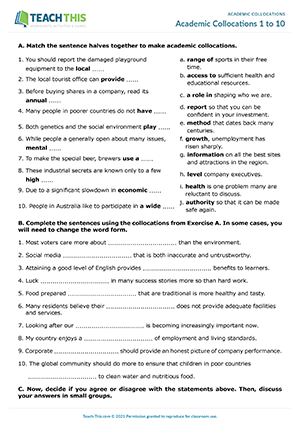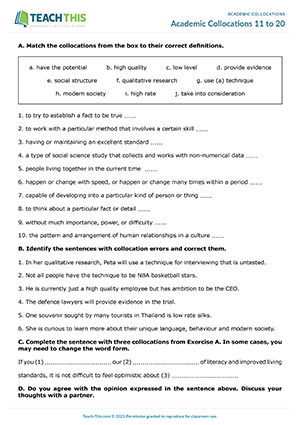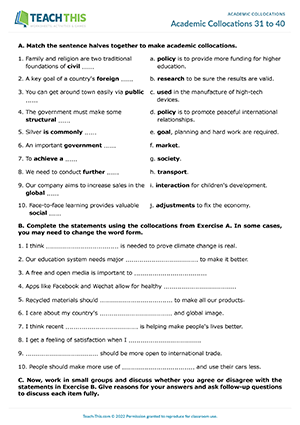- Grammar
- Active vs. Passive Voice
- Adverbial Clauses
- Adverbial Phrases
- Be Going To Statements
- Be Going To Wh Questions
- Be Going To Yes/No Questions
- Be Going To & Present Continuous
- Comparatives
- Superlatives
- Comparatives & Superlatives
- Zero Conditional
- First Conditional
- Second Conditional
- Third Conditional
- Mixed Conditionals
- Future Continuous
- Future Continuous vs. Future Perfect
- Future Perfect Continuous
- Past Simple Affirmative & Negative
- Past Simple Passive
- Past Simple Regular Verbs
- Past Simple Was and Were
- Past Simple Wh Questions
- Past Simple Yes/No Questions
- Past Simple vs. Past Continuous
- Past Simple vs. Present Perfect
- Past Tenses
- Present Continuous
- Present Perfect
- Present Perfect Continuous
- Present Perfect - Ever and Never
- Present Perfect - For and Since
- Present Perfect - Just, Yet & Already
- Present Perfect Wh Questions
- Present Perfect Yes/No Questions
- Present Simple Affirmative & Negative
- Present Simple Passive
- Present Simple vs. Present Continuous
- Present Simple vs. Present Perfect
- Present Simple Wh Questions
- Present Simple Yes/No Questions
- Present Tenses
- Punctuation
- Question Words
- Relative Clauses
- Reported Speech
- Subject-Verb Agreement
- Tag Questions
- There is & There are
- Used to
- Verb to be
- Wh Questions
- Parts of Speech
- Abstract Nouns
- Adjectives
- Adjective-Noun Collocations
- Adjectives of Feeling & Emotion
- Adjectives of Opinion
- Adjectives of Quantity
- Adjective Opposites
- Adjective Order
- Adjective-Preposition Collocations
- -ed and -ing Adjectives
- Adverb-Adjective Collocations
- Adverb Order
- Adverbs of Affirmation & Negation
- Adverbs of Degree
- Adverbs of Frequency
- Functional Language
- Vocabulary
- Academic English
- Business English
- Games
- Ideas
- Join Now
Newsletter
Sign up for our monthly newsletter and keep up-to-date with our latest resources, news and website features.
Thank you!
You have successfully joined our subscriber list.
Latest Free
Resources
- Jigsaw Reading
Reading Exam Preparation (B1)
Date Added: 7th of March
- Writing Jeopardy
Writing Exam Preparation (B1)
Date Added: 6th of March
- Present Perfect Bingo
Present Perfect Yes No Questions (A2)
Date Added: 4th of March
- Count on Me!
Making Offers and Promises (A2)
Date Added: 11th of February
- It’s Carnival Time!
Cultural Celebrations (B1)
Date Added: 29th of January
Latest Member
Resources
- Shops and What They Sell
Shopping (B1)
Date Added: 12th of March
- Who has written this?
Present Perfect Yes No Questions (A2)
Date Added: 11th of March
- Business Greetings and Introductions
Networking (B2)
Date Added: 11th of March
- Have you done this?
Present Perfect Yes No Questions (A2)
Date Added: 7th of March
- True, False or Not Given
Reading Exam Preparation (B2)
Date Added: 7th of March
Here's what our members are saying...
There are a lot of resources that are useful for teaching English. I downloaded the games which are handy and use them in my classes. With the games, my students never skip class or feel tired to learn English. The resources for teaching English helped my students progress in grammar, vocabulary, writing and comprehension. They also helped me a lot to guide my students to learn in a practical way.
Thank you for providing these incredible resources. Teach-This.com is always my go-to site for class activities, and I recommend it often. I love how it is organized. I can find resources for a specific grammar concept or language function by level and type of activity. Every time I visit your site, I discover a new classroom interaction strategy that's perfect for teaching the concept I'm focusing on! When I return after the holidays, yours will be the first subscription I restart.
I am an ESOL teacher, and the resources have helped my classes enormously. In particular, the speaking activities were a great help for my intermediate students before their exam. The website is user-friendly, and I will continue to utilise the resources - next term is reading and comprehension, so I will be looking for more resources from you. Thank you for such helpful activities and worksheets. They save me a lot of time in class preparation.
Teach This is an absolutely brilliant website, offering a vast amount of high-quality content, much of it free. Everyone involved in its creation deserves commendation. The leadership's vision has my deepest respect and gratitude. It's undoubtedly the best resource for English teachers, with its clear layout, easy navigation, concise messaging, and lack of invasive advertising - rare qualities that Teach This has perfected.
When I need to add or change an activity from my school’s curriculum, I always turn to TeachThis. While our curriculum is usually very good, it sometimes doesn’t fit well with my students. With TeachThis, I can easily find activities that match my topic and level, and the resources make my classes more interesting and varied. I look forward to the monthly newsletter and exploring new materials for inspiration. Please keep it up!
I like the efficiency and organization of the website. The resources cater to various levels with topic-based options for higher levels. The worksheets are very engaging and the answer keys are particularly helpful for teacher. The resources are also highly specific to levels and outcomes, making planning much easier. Finding what I need is simple and time-saving with the keyword search feature. Everything is clear and straightforward.
The easy and ready-to-go materials have helped me a lot during the last few years. Most of all I like the grammar games that activate my pupils and keep them engaged. My lessons have become way more playful and varied. Additionally, I like the grammar worksheets which I use to consolidate what I have worked on during class. The website is very user-friendly, and I have never had any difficulties finding what I was looking for.
A friend told me about the site, and it's awesome. I have found the Business English resources especially engaging and relevant for my students as the materials help them understand business writing and terms. My teaching experience has also improved from using the games on the site as they allow me to teach in a fun way. The user experience is outstanding. Great job!
I found Teach-This a long time ago when I started teaching. It's always had great resources. I really appreciate the grammar materials, board games, and group activities. They've saved me lots of time on lesson planning. The materials are easy to use and understand, making my job much simpler. The best thing is that many resources can be downloaded for free. I've used it for around 8 years, and it consistently offers great content.
I use the resources from the Games Section as part of my daily 30-minute morning warm-up activities, and I've received rave reviews for using them. The games help me maintain student interest and participation and leave the students feeling happy and awake. I like everything about the site, and customer support is very effective as they respond in time.
Teach-This is one of the best EFL websites I've found. It's extremely user-friendly, and I always find what I need quickly. I like the design, and the content is fun, engaging and original. I am very thankful for all your work and generosity by making some resources free. I always recommend this website to my fellow teachers. Your work is really helpful, and I value it enormously.
I like the grammar-focused resources the most as they save me time. The resources also inspire me. If I see an interesting grammar activity, I often rework it for other grammar rules. I like the fact that I simply pay a flat fee, and I can download whatever I want. Teach-This really is a great timesaver. I know that if I am in need of resources for my students, I can go to Teach-This and find something interesting.
Getting familiar with the site and how to use the resources is not difficult. I found the writing skills resources to be the most valuable as they have enhanced my teaching of this skill. The website is elaborate and full of all types of resources to help me teach English. When I contacted customer support, they were super-fast to deal with my enquiry. So overall, I recommend it.
I have found the grammar and vocabulary resources the most valuable. They have improved my teaching experience because they are easy to use and well-organized. The materials are very engaging for my students. The website is also very user-friendly. The best thing about Teach-This is that it offers ready-made worksheets for busy teachers, and the content is well-organized and full of information.
I'm really glad I found the Teach-This website. The materials in the General English section have proven to be really helpful and made my classes more engaging. The materials are well-structured and cover a wide range of topics, making it easy to keep my students interested and motivated. Overall, my experience using your resources has been great.
My first impression of the website was that it was amazing. The games and activities have really improved my teaching. The resources are engaging and relevant to my students’ needs, and I find the website easy to use and navigate. Thanks.
I discovered the site on Google when I was searching for question games and reading activities. It has been very helpful. The activities are awesome and have benefited me and my students by making my classes more fun. I am now less stressed about preparing for classes as the ready-made resources offer me everything I need. I give the site five out of five for user-friendliness. It is very easy to navigate and find what I need.
I would like to thank you for making a fantastic website. I particularly enjoy teaching the functional language materials, which have been very helpful in my classes. The resources have significantly improved my students' communication skills in daily life, so it was rewarding to see them benefit in this way. It feels great to be able to make a difference in my students' lives. Please keep up the good work.
- Home
- Grammar
- Active vs. Passive Voice
- Adverbial Clauses
- Adverbial Phrases
- Be Going To Statements
- Be Going To Wh Questions
- Be Going To Yes/No Questions
- Be Going To & Present Continuous
- Comparatives
- Superlatives
- Comparatives & Superlatives
- Zero Conditional
- First Conditional
- Second Conditional
- Third Conditional
- Mixed Conditionals
- Future Continuous
- Future Continuous vs. Future Perfect
- Future Perfect Continuous
- Future Perfect Simple
- Future Simple
- Future Tenses
- Future Time Clauses
- Gerunds & Infinitives
- Have got & Has got
- I wish & If only
- Imperatives
- Irregular Verbs
- Narrative Tenses
- Noun Clauses
- Noun Phrases
- Passive Voice
- Past Continuous
- Past Perfect
- Past Perfect Continuous
- Past Perfect Simple & Continuous
- Past Simple Affirmative & Negative
- Past Simple Passive
- Past Simple Regular Verbs
- Past Simple Was and Were
- Past Simple Wh Questions
- Past Simple Yes/No Questions
- Past Simple vs. Past Continuous
- Past Simple vs. Present Perfect
- Past Tenses
- Present Continuous
- Present Perfect
- Present Perfect - Ever and Never
- Present Perfect - For and Since
- Present Perfect - Just, Yet & Already
- Present Perfect Wh Questions
- Present Perfect Yes/No Questions
- Present Perfect Continuous
- Present Simple Affirmative & Negative
- Present Simple Passive
- Present Simple vs. Present Continuous
- Present Simple vs. Present Perfect
- Present Simple Wh Questions
- Present Simple Yes/No Questions
- Present Tenses
- Punctuation
- Question Words
- Relative Clauses
- Reported Speech
- Subject-Verb Agreement
- Tag Questions
- There is & There are
- Used to
- Verb to be
- Wh Questions
- Parts of Speech
- Abstract Nouns
- Adjectives
- Adjective-Noun Collocations
- Adjectives of Feeling & Emotion
- Adjectives of Opinion
- Adjectives of Quantity
- Adjective Opposites
- Adjective Order
- Adjective-Preposition Collocations
- -ed and -ing Adjectives
- Adverb-Adjective Collocations
- Adverb Order
- Adverbs of Affirmation and Negation
- Adverbs of Degree
- Adverbs of Frequency
- Adverbs of Manner
- Adverbs of Place
- Adverbs of Time
- Articles - a, an, the
- Causative Verbs
- Collective Nouns
- Common & Proper Nouns
- Compound Adjectives
- Compound Nouns
- Concrete nouns
- Conjunctions
- Countable & Uncountable Nouns
- Demonstrative Adjectives
- Demonstrative Pronouns
- Dependent Prepositions
- Indefinite Pronouns
- Intensifiers & Mitigators
- Interjections
- Modal Verbs of Ability
- Modals of Deduction & Speculation
- Modals of Necessity
- Modals of Obligation & Prohibition
- Modals of Possibility & Certainty
- Onomatopoeia
- Parts of Speech
- Phrasal Verbs
- Possessives
- Prefixes
- Prepositions of Movement
- Prepositions of Place
- Prepositions of Time
- Proper Adjectives
- Quantifiers
- Reflexive Pronouns
- Sense Verbs & Adjectives
- Singular & Plural Nouns
- So and Such
- Subject & Object Pronouns
- Suffixes
- Too and Enough
- Transition Words
- Verb-Noun Collocations
- Verbs
- Functional Language
- Agreeing & Disagreeing
- Air Travel
- Asking for Permission
- At the Dentist's
- At the Doctor's
- Being Polite
- Classroom Language
- Complaining & Apologizing
- Complimenting
- Critical Thinking & Problem Solving
- Dealing with Problems
- Describing Character & Personality
- Describing People's Appearance
- Describing Places
- Describing Things
- Emailing
- Etiquette and Manners
- Expressing Preferences
- Getting Around
- Getting to Know You
- Giving Advice
- Giving Directions
- Giving Opinions
- Giving Personal Information
- Greetings & Introductions
- Holidays
- Indirect Questions
- Likes and Dislikes
- Making Arrangements
- Making Decisions
- Making Excuses
- Making Invitations
- Making Offers & Promises
- Making Requests
- Making Suggestions
- Online Communication
- Ordering Food & Drink
- Shopping
- Small Talk
- Social Media
- Telephoning
- Times and Dates
- Travel
- Vocabulary
- Actions
- Animals
- Birthdays
- British English vs. American English
- Christmas
- Cities, Towns & Places
- Clothes & Fashion
- Colours
- Computers & Smartphones
- Countries & Nationalities
- Crime, Law & Punishment
- Cultural Celebrations
- Daily Routines
- Easter
- Education Vocabulary
- Everyday Objects
- Family & Relationships
- Food & Drink
- Going Out & Entertainment
- Halloween
- Health & Fitness
- Hobbies & Free Time
- Houses, Rooms & Furniture
- Idioms
- Jobs & the Workplace
- Love, Romance & Dating
- Modes of Transport
- Money
- Music
- Numbers
- Parts of the Body
- Reading Comprehension
- Seasons
- Shapes & Measurements
- Space
- Sports
- The Natural World
- Time Expressions
- TV & Film
- Valentine's Day
- Weather
- Academic English
- Academic Collocations
- Academic Phrasal Verbs
- AWL Sublist 1 and 2
- Cause and Effect Essays
- Compare and Contrast Essays
- Critical Thinking
- Debating
- Discussion Essays
- Discussion Skills
- Discussions Practice
- Essay Writing
- Intercultural Communication
- Paragraph Writing
- Persuasive Essays
- Presentation Skills
- Problem Solution Essays
- Reading Comprehension
- Reading Exam Preparation
- Reading Skills
- Referenced Essays
- Speaking Test Preparation
- Study Skills
- Writing Exam Preparation
- The Writing Process
- Business English
- Business Collocations
- Business Emails
- Business Idioms
- Business Meetings
- Business Negotiations
- Business Phrasal Verbs
- Business Problems
- Closing a Presentation
- Dealing with Complaints
- Describing Graphs & Charts
- Networking
- Presentation Language & Structure
- Resumes, CVs & Email Cover Letters
- Starting a Presentation
- Talking about Companies
- Talking about Jobs
- ESL Games
- Brainstorming Games
- Category Games
- Classic Childhood Games
- Counting Games
- Describing Games
- Drawing Games
- Drilling Activity Games
- First Day of Class Games
- Flashcard Games
- Giving Answers Games
- Grammar Games
- Hangman Games
- Listening Games
- Miming Games
- Music Games
- Question & Answer Games
- Quiz Games
- Sentence Race Games
- Spelling Games
- TV Game Shows
- Verb Games
- Vocabulary Games
- Word Association Games
- Word Games
- Yes/No Question Games
- Ideas
- Classroom Interaction Patterns
- Classroom Management
- Concept Checking
- Cultural Awareness
- Developing Students' Listening Skills
- Developing Students' Reading Skills
- Developing Students' Speaking Skills
- Eliciting Techniques
- ESL Dictations
- How to Introduce a Lesson
- How to Use Music in ESL Class
- Lesson Planning
- Making Teaching Materials Relevant
- Problems Learning English
- Teaching English Idioms
- Teaching English Vocabulary
- Teaching Large Classes
- Teaching Mixed-Ability Classes
- Teaching Small Classes
- The First Day of Class
- Using Correction in Class
- Using Song Gap Fills
- Online Membership
- ESL Essentials eBook Series
- Online Platform Tutorial
- TEFL Certification & Courses
- Join our Team
- Contact Us / FAQ
- About Us
- Privacy Policy
- Terms of Use







